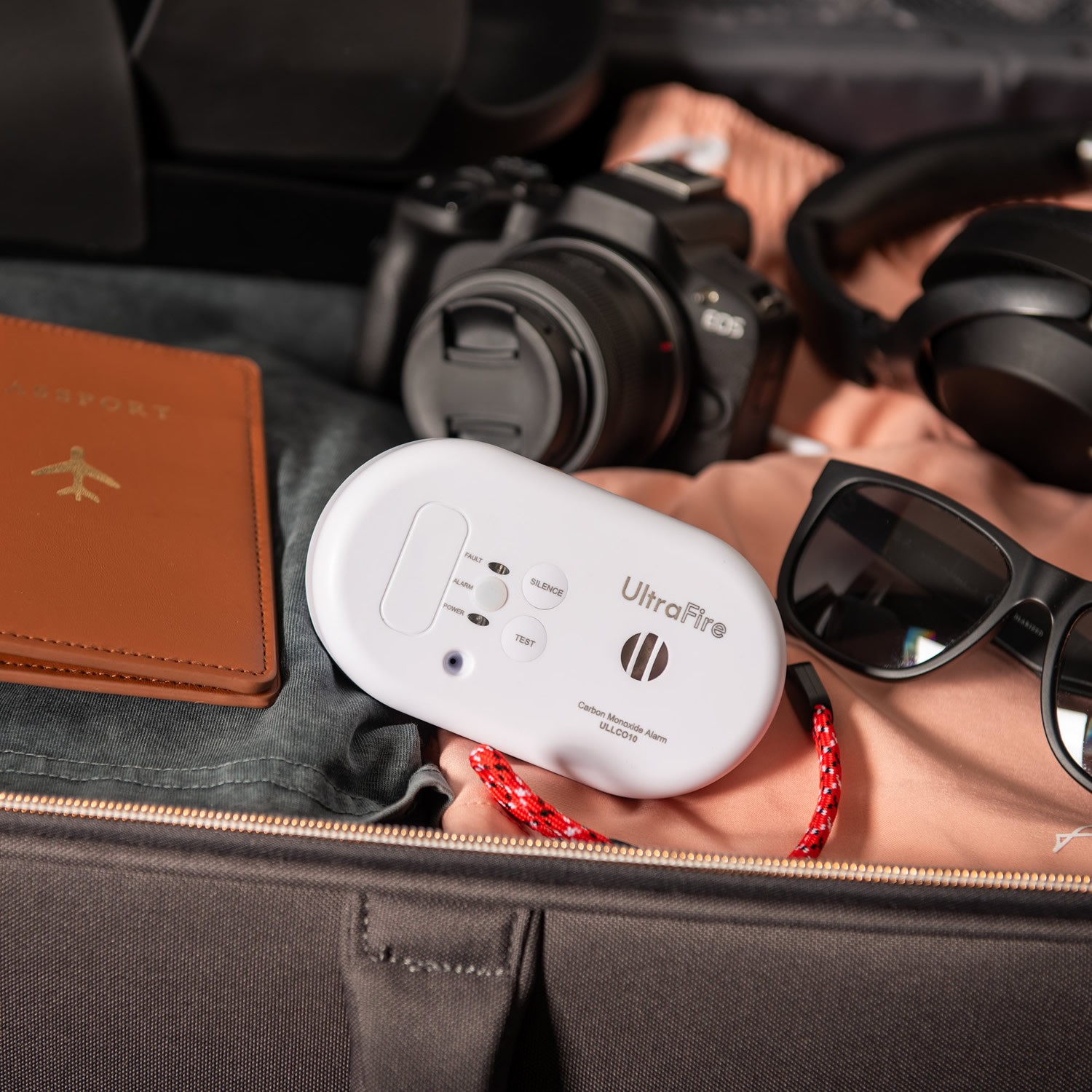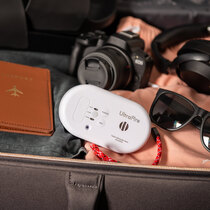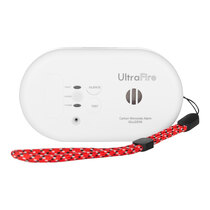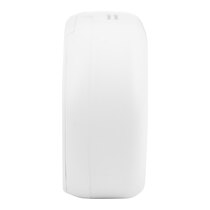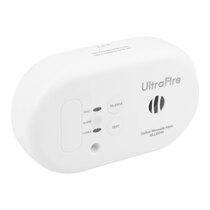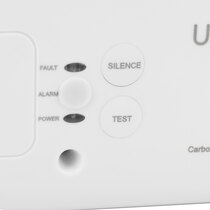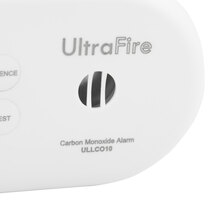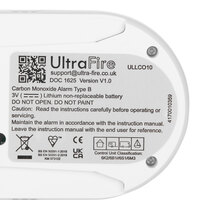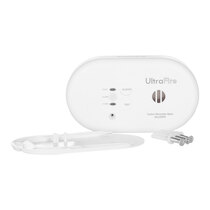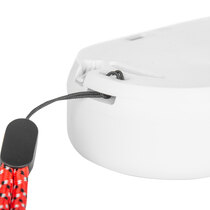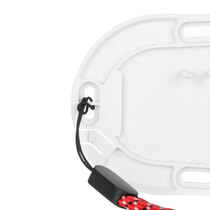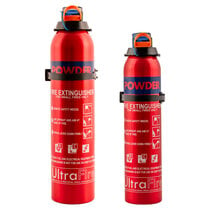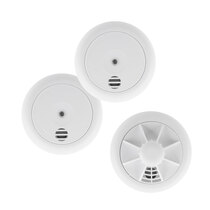-
Contact
Sales & Customer Service
0800 612 6537 support@safelincs.co.uk Live ChatDelivery Enquiries
0800 077 6149 - Resources
Fire & Safety Solutions
CALL OUR TEAM NOW 0800 612 6537
Lines open today 8am - 6pm
Quick Delivery
From £3.19 inc VAT
Live Chat - Online
Instant help & Advice
Trade Discounts
and exclusive pricing
0% Credit Available
Open an account now
5 Star Customer Feedback
Travel Longlife Battery Carbon Monoxide Detector – UltraFire ULLCO10 with Strap
Product Overview
Technical Data
FAQs (7)

Designed with travel in mind, the UltraFire ULLCO10 carbon monoxide alarm with travel strap is ideal for use whilst travelling. Kitemarked to BS EN 50291-1 and BS EN 50291-2, the CO alarm can be used in caravans, motorhomes, boats, and whilst camping. Carbon Monoxide is undetectable by all human senses and in order to be warned of this deadly gas, this alarm will alert you when it is present. The travel strap supplied with the alarm allows for the device to be clipped to your backpack, as well as being able to be mounted to the wall, or left free standing.
- Ideal for backpackers, holiday makers, and campers
- Suitable for homes, hostels, Airbnb's, and especially rooms with a fuel burning appliance
- Travel strap can be clipped to a backpack, or inside of a tent
- Alerts you to the presence of carbon monoxide
- Product Life: 10 years
- Battery: 10-year longlife battery (sealed lithium)
- Warranty: 10-year warranty
- Compact and lightweight design for portability
- LED indicators for power (green), alarm (red), and fault (amber)
- Certification for a variety of uses:
- BS EN 50291-1 for home and static caravans
- BS EN 50291-2 for caravans, motorhomes, camping, boat, and general travel
- Clear, loud 85dB alarm
- Separate test and silence buttons for easy testing and maintenance
- End-of-life audible warning at 10 years
- Supplied with a screw pack for wall mounting
| Product Code | UFULLCO10-WS |
|---|---|
| Brand | UltraFire |
| Battery Type | 10 Year Sealed Lithium |
| Dimensions (HxWxD) | 67 x 115 x 34mm |
| Display | LED Indicators |
| Operating Temperature | -10°C to +40°C |
| Relative Humidity | 30% to 90% RH (non-condensing) |
| Sensitivity | 30ppm (parts per million) CO gas |
| Sound Output | 85dB at 3 metres |
| Warranty | 10 Years |
| Weight | 0.13kg |
| Product Datasheets |
Q. What is the best way to dispose of an old smoke alarm or carbon monoxide detector?
A.
Safelincs has signed up to Valpak's WEEE (Waste Electrical and Electronic Equipment) Distributor Take-Back Scheme*. This means if you are a Safelincs customer you can take old smoke, heat and CO alarms to your local recycling centre.
To find your nearest recycling centre, please visit www.recycle-more.co.uk. Find out more about smoke alarm disposal.
*Registration ID: 7370
Q. Why is carbon monoxide dangerous?
A.
Carbon monoxide (CO) is a colourless, odourless, tasteless gas that is undetectable by humans. Inhaling CO reduces the blood's ability to carry oxygen to the body's organs and cells.
Each year, over 50 people die in the UK from exposure to carbon monoxide. Many more people die through strokes and respiratory illnesses made worse by inhaling low levels of CO over prolonged periods.
To protect you and your family, purchase a carbon monoxide detector and use the test button weekly to check it is in working order.
Q. What are the symptoms of carbon monoxide poisoning?
A.
The symptoms of CO poisoning can range from mild flu-like symptoms such as headache, drowsiness, confusion, nausea and dizziness to more severe symptoms like breathing difficulties and irregular heartbeat. CO poisoning can ultimately lead to coma and death.
View more symptoms on our carbon monoxide information page.
Q. Where are carbon monoxide alarms required?
A.
Most legislation advises at least one carbon monoxide alarm is fitted near new or replacement fuel-burning appliances that are fixed installations, though rented properties (both social and private sector) often require CO alarms be provided by landlords even if no appliances are being installed or replaced. Examples include boilers, coal fires, wood burners, and gas ovens and cookers, though an exception is often made in legislation for gas appliances solely used for cooking.
However, any and all materials can give off CO when burning, including gas cookers. Carbon monoxide can also spread from neighbouring properties or outside sources such as vehicle fumes. Because of this, Safelincs strongly recommends the installation of carbon monoxide detectors in every home, and also at head-height in bedrooms to protect occupants while sleeping.
Landlords, please see our pages for English, Welsh, and Scottish alarms or our landlord guidance page for more information.
Q. Where should carbon monoxide detectors be positioned?
A.
CO detectors should be installed near potential sources of carbon monoxide, essentially any fuel-burning appliances. As you are likely to be most affected by CO in areas of your home that you spend the most time in it is advisable to install alarms in those areas as well, such as at head height in the living room and bedrooms. If your property has an attached garage with a connecting door through to the house, it is recommended to fit a CO alarm inside the house leading from that doorway.
Carbon monoxide has been proven to spread into neighbouring properties through open windows, as well as through loft spaces in semi-detached or terrace houses.
Battery powered carbon monoxide alarms can typically be installed wall-mounted or left free-standing on flat, level surface. Combined smoke & CO alarms or mains-powered CO alarms are typically installed on the ceiling.
- Near an appliance: they should be placed within 1 to 3 metres horizontally from the appliance and between the height of the appliance to 150mm below the ceiling – i.e., not above a stove where it would be in the path of steam or fumes.
- In living spaces: they should be positioned close to where the occupant's head is likely to be most of the time – e.g., on your bedside table.
- On the ceiling: at least 30cm away from any wall, light fitting, or other obstruction.
Do not install CO alarms within 3 metres of doors or windows, above radiators, or immediately close to anything that gives off steam or fumes like a cooker or shower room. Similarly, it is not recommended to install detectors in dusty areas such as workshops or garages.
For more information, please check the manufacturer's instructions – you can download the PDF manual from the relevant product page on our site. You can also watch our video guide to positioning CO detectors.
Q. What level of carbon monoxide is dangerous?
A.
See our carbon monoxide information page for more details.
Different levels of carbon monoxide (CO) affect the body in different ways. Exposure to large amounts of CO can cause sudden death, and prolonged exposure to low levels of carbon monoxide can have adverse effects on the body and brain.
This table shows the effects of different levels of exposure to carbon monoxide.
| Concentration of CO in the air | Implications of Exposure |
| 10 parts per million (ppm) | Threshold at which prolonged exposure can have adverse effects on the body and brain. This can include neuropsychological and cardiovascular issues. |
| 50 parts per million (ppm) | Safety level as specified by the Health and Safety Executive for a maximum of 30 minutes. |
| 200 PPM | Slight headache within 2-3 hours. |
| 400 PPM | Frontal headache within 1-2 hours, becoming widespread in 3 hours. |
| 800 PPM | Dizziness, nausea, convulsions within 45 minutes, insensible in 2 hours. |
See our carbon monoxide information page for more details.
Q. Are Carbon Monoxide Detectors Required by Law?
A.
In short: yes, but there isn't just one, single rule to follow.
Legislative requirements for carbon monoxide alarms vary by which country of the UK your house is in and whether it is rented or owner-occupied. Most legislation requires at least one carbon monoxide alarm is fitted near new or replacement fuel-burning appliances (e.g. boiler, oven, fire place), specifically either 'tamper-proof' / 'sealed for life' alarms such as those using lithium batteries, or alternatively mains-powered models which are directly wired into mains supply as opposed to plug-in types. Some countries have exceptions for fuel-burning appliances used solely for cooking. Rented properties mostly require a CO alarm immediately even if no appliances are being installed or replaced.
Please see our page on carbon monoxide alarm legislation for more specific guidance, links to relevant legislation & government guidance, and links to carbon monoxide alarms suitable for each. Alternatively, please view our full range of carbon monoxide alarms if you already know what type you need.
Key Product Features
What's Included?
Every UltraFire UFULLCO10-WS is supplied with the following components.
- 1 x UltraFire ULLCO10 carbon monoxide alarm
- 1 x Sealed 10-year lithium battery
- 1 x Screw fixing set (screws & rawl plugs)
- 1 x Instruction manual
- 1x Travel strap

Pricing & Availability
| Model | Stock | 1 unit | 2+ units | 5+ units |
|---|---|---|---|---|
| Product Code: UFULLCO10-WS |
Stock Level:
More than 20 in stock Expected dispatch: Today
|
1 unit
£21.77 inc VAT £18.14 ex VAT |
2+ units
£21.17 inc VAT £17.64 ex VAT |
5+ units
£20.87 inc VAT £17.39 ex VAT |
Approved Partner
Delivery Options
The following delivery options are available on this product.
Looking for more information?
If you have any questions or would like more information about this product you can ask one of our specialists.
Live Chat Available Now
Direct Telephone
01507 464182




















